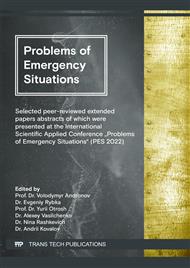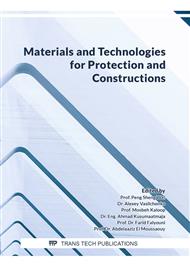[1]
Bashynska, O., Otrosh, Y., Holodnov, O., Tomashevskyi, A., & Venzhego, G. Methodology for Calculating the Technical State of a Reinforced-Concrete Fragment in a Building Influenced by High Temperature. In Materials Science Forum, 1006 (2020) 166-172.
DOI: 10.4028/www.scientific.net/msf.1006.166
Google Scholar
[2]
A. Kondratiev, V. Píštěk, L. Smovziuk, M. Shevtsova, A. Fomina, P. Kučera, Stress–strain behaviour of reparable composite panel with step–variable thickness, Polymers, 13 21 (2021) 3830.
DOI: 10.3390/polym13213830
Google Scholar
[3]
Zhang, H. Y., Lv, H. R., Kodur, V., & Qi, S. L., Performance comparison of fiber sheet strengthened RC beams bonded with geopolymer and epoxy resin under ambient and fire conditions. Journal of Structural Fire Engineering, 9(3) (2018) 174–188.
DOI: 10.1108/jsfe-01-2017-0023
Google Scholar
[4]
Hertz, K., Giuliani, L., & Sørensen, L. S., Fire resistance of extruded hollow-core slabs. Journal of Structural Fire Engineering, 8(3) (2017) 324–336.
DOI: 10.1108/jsfe-07-2016-0009
Google Scholar
[5]
Franssen, J. M., & Gernay, T., Modeling structures in fire with SAFIR®: Theoretical background and capabilities. Journal of Structural Fire Engineering, 8(3) (2017) 300–323.
DOI: 10.1108/jsfe-07-2016-0010
Google Scholar
[6]
Mwangi, S., Why Broadgate Phase 8 composite floor did not fail under fire : Numerical investigation using ANSYS® FEA code. Journal of Structural Fire Engineering, 8(3) (2017) 238–257.
DOI: 10.1108/jsfe-05-2017-0032
Google Scholar
[7]
Walls, R., Viljoen, C., & de Clercq, H., Parametric investigation into the cross-sectional stress-strain behaviour, stiffness and thermal forces of steel, concrete and composite beams exposed to fire. Journal of Structural Fire Engineering, 11(1) (2020) 100–117.
DOI: 10.1108/jsfe-10-2018-0031
Google Scholar
[8]
M, V., & K.S, S., A review on research of fire-induced progressive collapse on structures, Journal of Structural Fire Engineering. (2021) Emerald Group Holdings Ltd.
Google Scholar
[9]
Li, S., Jiaolei, Z., Zhao, D., & Deng, L., Study on fire resistance of a prefabricated reinforced concrete frame structure. Journal of Structural Fire Engineering, 12(3) (2021) 363–376.
DOI: 10.1108/jsfe-12-2020-0039
Google Scholar
[10]
Golovanov, V. I., Pekhotikov, A. V., & Pavlov, V. V., Fire protection of steel and reinforced concrete structures of industrial buildings and structures. Bezopasnost' Truda v Promyshlennosti, 9 (2021) 50–56.
DOI: 10.24000/0409-2961-2021-9-50-56
Google Scholar
[11]
Poklonskiy, V., Krukovskiy, P., & Novak, S., Raschet zhelezobetonnoy plity perekrytiya pri vozdeystvii povyshennykh temperatur pozhara. Naukoviy vіsnik: tsivіlniy zakhist ta pozhezhna bezpeka, 2(10) (2021) 69–82.
Google Scholar
[12]
O.Z. Dveirin, O.V. Andreev, A.V. Kondrat'ev, V.Ye. Haidachuk, Stressed state in the vicinity of a hole in mechanical joint of composite parts. International Applied Mechanics, 57 2 (2021) 234-247.
DOI: 10.1007/s10778-021-01076-4
Google Scholar
[13]
ENV 1993-1-2:2005. Eurocode 3, Design of steel structures, Part 1.2, general rules – Structural fire design.
Google Scholar
[14]
Kovalov, A., Otrosh, Y., Semkiv, O., Konoval, V., & Сhernenko, O., Influence of the fire temperature regime on the fire-retardant ability of reinforced-concrete floors coating, In Materials Science Forum, 1006 (2020) 87–92.
DOI: 10.4028/www.scientific.net/msf.1006.87
Google Scholar
[15]
Kovalov, A. I., Otrosh, Y. A., Kovalevska, T. M., & Safronov, S. O., Methodology for assessment of the fire-resistant quality of reinforced-concrete floors protected by fire-retardant coatings. In Materials Science and Engineering. IOP Publishing, 708 (1) (2019) 012058.
DOI: 10.1088/1757-899x/708/1/012058
Google Scholar
[16]
Sadkovyi, V., Andronov, V., Semkiv, O., Kovalov, A., Rybka, E., Otrosh, Y., Udianskyi, M., Koloskov, V., Danilin, A., Kovalov, P., Fire resistance of reinforced concrete and steel structures: monograph, Kharkiv: PC TECHNOLOGY CENTER. (2021) 180 p.
DOI: 10.15587/978-617-7319-43-5
Google Scholar



